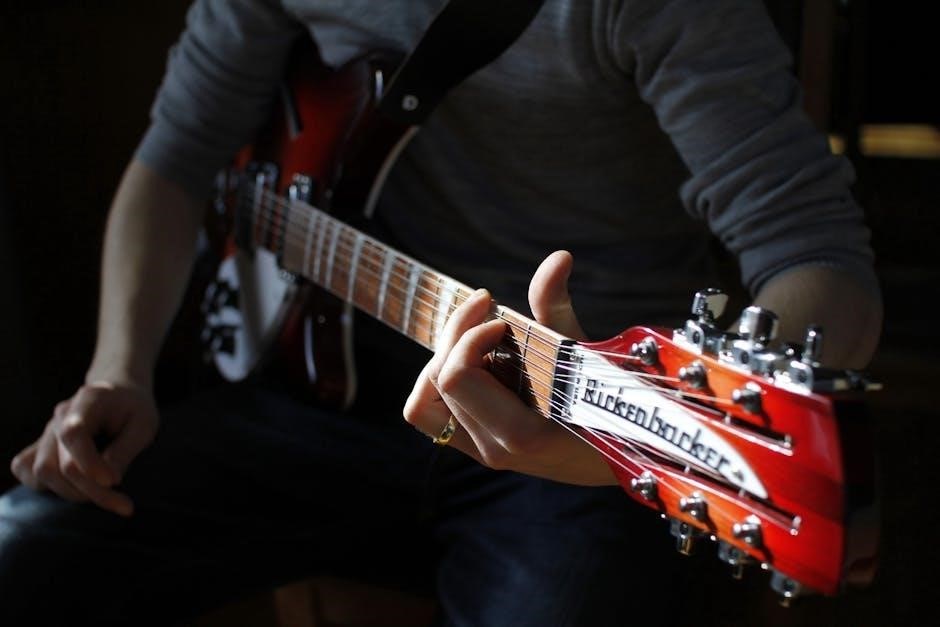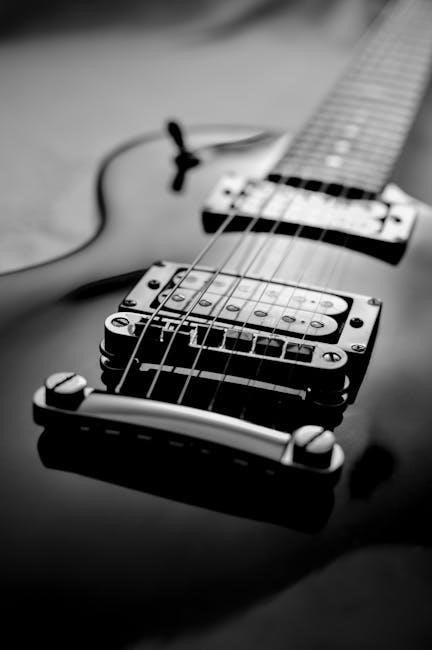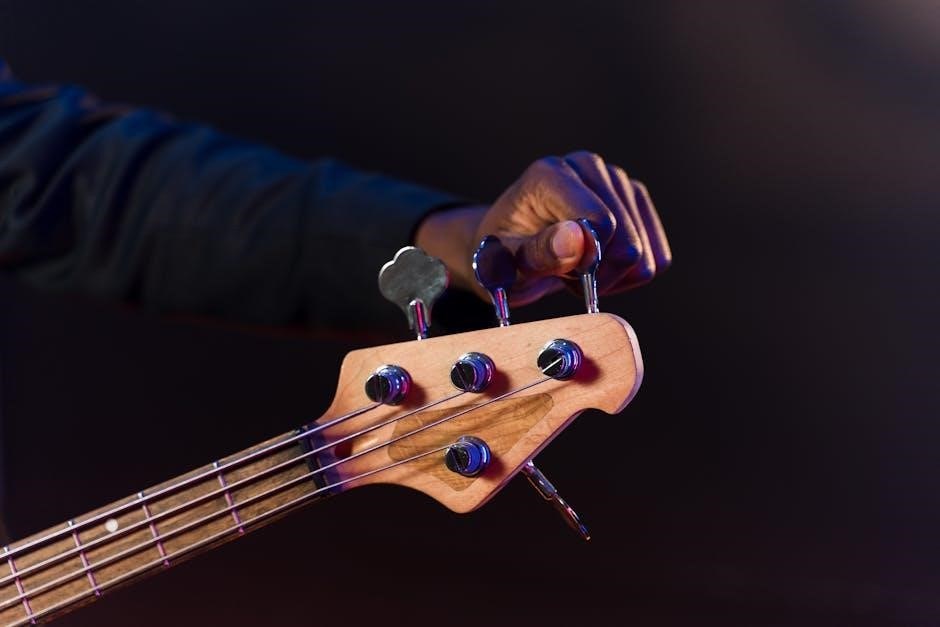A guitar fretboard PDF is a digital resource designed to help guitarists learn and visualize the fretboard layout, including notes, chords, and scales. It’s a printable tool suitable for all skill levels, offering a clear and organized way to understand the guitar neck. Perfect for practice, lessons, and quick reference, these PDFs provide a comprehensive guide to mastering the fretboard.
What is a Guitar Fretboard PDF?
A guitar fretboard PDF is a digital document designed to provide a visual and interactive guide to the guitar neck. It typically includes detailed diagrams of the fretboard, showcasing notes, chords, and scales in an organized manner. These PDFs are often printable, allowing guitarists to use them for practice, lessons, or quick reference. They cater to all skill levels, from beginners learning the basics to advanced players refining their techniques. Many fretboard PDFs offer blank charts for customization, enabling users to create personalized chord and scale diagrams. Others include pre-filled charts that highlight note positions, making it easier to understand the layout of the guitar neck. This resource is invaluable for musicians seeking to improve their understanding and mastery of the fretboard.
Benefits of Using a Guitar Fretboard PDF
Using a guitar fretboard PDF offers numerous benefits for guitarists. It provides a clear, visual guide to the fretboard layout, making it easier to learn and memorize notes, chords, and scales. The portability of PDFs allows musicians to access these resources anywhere, whether practicing at home or during lessons. Many PDFs are customizable, enabling users to create personalized charts for specific techniques or songs. Additionally, fretboard PDFs are often free or low-cost, making them an affordable tool for learning. They also cater to all skill levels, from beginners to advanced players, and can be printed for hands-on study. This versatility makes them an essential resource for anyone aiming to master the guitar fretboard.

How to Download and Use Guitar Fretboard PDFs
To download and use guitar fretboard PDFs, visit reputable websites, select your desired chart, and save it to your device. Print the PDF for physical use or view it digitally. These resources are ideal for learning notes, chords, and scales, and many are free. Use them to practice, plan lessons, or create custom charts for specific techniques. Their portability and versatility make them a valuable tool for guitarists of all skill levels.

Where to Find Free Guitar Fretboard PDFs
Free guitar fretboard PDFs are widely available online, offering convenient access to learning tools. Websites like egalo.com, unlocktheguitar.net, and ebassguitar.com provide high-quality, downloadable resources. These sites feature blank and note-filled charts, ideal for musicians of all levels. Many PDFs are designed for printing, allowing you to practice scales, chords, and note memorization offline. Some resources also include customizable templates for creating personalized charts. Additionally, platforms like rickysguitar.com and guitar-catalogue.uselesstheory.si offer free PDFs without requiring registration. These tools are perfect for guitarists seeking to enhance their fretboard knowledge and improve their playing skills. With so many options available, finding the right PDF to suit your needs is easy and accessible;
How to Download and Print Guitar Fretboard Charts
Downloading and printing guitar fretboard charts is straightforward. Most websites offer direct links to PDF files, which can be accessed by clicking on the provided buttons or images. Once opened in your browser, you can save the PDF to your device by right-clicking and selecting “Save As.” For printing, ensure your printer is set to the correct paper size, such as A4 or letter, and use high-quality settings for clarity; Some charts are designed with no margins for full-bleed printing, while others include multiple fretboards per page for convenience. Many resources are free and require no registration, making it easy to print and start practicing scales, chords, and note memorization. Always check the website’s instructions for specific download and printing tips to ensure the best results.
Understanding the Guitar Fretboard Layout
The guitar fretboard layout visually organizes notes across the neck, showing their positions on each string and fret. This design helps musicians learn scales, chords, and navigation efficiently.
Visual Representation of the Fretboard
A guitar fretboard PDF provides a detailed visual map of the fretboard, showcasing the layout of notes, strings, and frets. This clear representation helps guitarists understand the relationship between notes and their positions on the neck. The PDF often includes labeled notes, octave markings, and sometimes chord or scale patterns, making it easier to visualize musical concepts. Many resources offer both blank and annotated charts, allowing users to test their knowledge or reference notes as needed; These visual tools are especially useful for beginners learning the fretboard layout and for advanced players refining their understanding of scales and chords. The ability to print these charts ensures that guitarists can practice and study offline, reinforcing their learning process effectively.
Notes on the Fretboard: A Comprehensive Guide

A guitar fretboard PDF offers a detailed guide to understanding the notes on the fretboard, including their positions, relationships, and octaves; These resources often label natural notes, sharps, and flats, providing a clear visual aid for learning. The PDFs typically cover all 6 strings and up to 24 frets, making it easy to identify notes across the entire neck. Many guides also explain how notes repeat in octaves and how sharps/flats relate to their natural counterparts. This comprehensive approach helps guitarists build a strong foundation for playing chords, scales, and melodies. Whether you’re a beginner or an advanced player, these guides simplify the process of mastering the fretboard’s note layout and understanding musical theory in a practical way.

Blank Guitar Fretboard Charts
Blank guitar fretboard charts are versatile tools for musicians to create custom chord, scale, and arpeggio diagrams. Available as high-resolution PDFs, they allow players to map notes, experiment with new techniques, and track progress. These charts are ideal for lesson planning, practice, and developing a deeper understanding of the fretboard layout. Perfect for teachers and students alike, blank charts provide a flexible framework for learning and creativity.

Purpose and Uses of Blank Fretboard Diagrams
Blank fretboard diagrams serve as versatile tools for guitarists to create custom chord, scale, and arpeggio charts. They provide a clean, minimal design, allowing musicians to map notes, experiment with new techniques, and track progress. Ideal for practice, lessons, and lesson planning, these diagrams are perfect for teachers and students alike. They enable players to visualize the fretboard layout, understand note positions, and develop muscle memory. Available as high-resolution PDFs, blank charts are customizable, making them suitable for all skill levels. Whether for learning scales, chords, or advanced techniques like string skipping, blank fretboard diagrams offer a flexible framework for mastering the guitar neck and exploring musical creativity.
How to Create Custom Guitar Chord and Scale Charts
To create custom guitar chord and scale charts, start by downloading high-resolution blank fretboard diagrams in PDF format. These templates provide a clean layout for mapping notes, chords, and scales. Use a pen or digital tools to mark note positions, finger placements, and patterns. Organize the information clearly, using colors to differentiate between chords and scales for better visual clarity. These charts are ideal for teaching, practice, or composing music. They allow you to focus on specific techniques, such as string skipping or the CAGED system, and track your progress over time. By customizing your own charts, you can tailor your learning to your musical goals and preferences, making the process more effective and engaging.

Guitar Scales and Chords on the Fretboard
Guitar scales and chords are visually mapped on the fretboard, providing a clear guide for musicians. PDF resources offer detailed diagrams, showcasing major, minor, pentatonic, and blues scales, as well as chord shapes and their positions. These tools help players understand note relationships and patterns, making learning and mastery more accessible for both beginners and advanced guitarists.
Major and Minor Scales: A Fretboard Perspective
Understanding major and minor scales is essential for guitarists, and a fretboard PDF provides a visual guide to their structure. A major scale follows the W-W-H-W-W-W-H pattern, while a minor scale uses W-H-W-W-H-W-W. These patterns are mapped across the fretboard, showing the relationship between notes. The PDF highlights how scales are constructed and their positions on the neck. It also explains how the relative minor of a major scale begins on the 6th note. This resource helps guitarists memorize scales and their intervals, making it easier to improvise and compose music. By visualizing these scales on the fretboard, players can better understand how notes connect and apply this knowledge to their playing.
Pentatonic and Blues Scales: Visual Guide

The pentatonic and blues scales are fundamental for guitarists, and a fretboard PDF offers a clear visual guide to their patterns. The pentatonic scale, with its five notes, is versatile for improvisation, while the blues scale adds a “blue” note for emotional depth. These scales are visually mapped across the fretboard, showing their positions and intervals. The PDF highlights how these scales can be played in multiple positions, making it easier to navigate the neck. It also demonstrates how string skipping and diagonal movements can enhance scale playing. By using these visual guides, guitarists can master the pentatonic and blues scales, improving their ability to create solos and melodies. This resource is invaluable for players looking to expand their musical expression and technique.
Chord Shapes and Their Positions on the Fretboard
A guitar fretboard PDF provides a detailed visual guide to chord shapes and their positions across the neck. It maps out the locations of major, minor, and seventh chords, along with their variations, such as barre chords and open chords. The PDF highlights how these shapes can be moved up and down the fretboard to create different chords, following the CAGED system. This resource also includes blank charts for creating custom chord diagrams, allowing guitarists to practice and memorize chord positions effectively. Whether you’re a beginner or an advanced player, the PDF offers a clear and organized way to master chord shapes and their placements, enhancing your ability to play and improvise with confidence.
Learning and Memorizing the Fretboard
Mastering the fretboard requires consistent practice and visualization. Printable PDFs offer structured drills, note charts, and exercises to help guitarists memorize notes, chords, and scales effectively. Regular use enhances familiarity and improves playing skills through systematic learning and repetition.
Techniques for Memorizing Fretboard Notes
Memorizing fretboard notes is essential for guitar mastery. One effective technique is using blank fretboard PDFs to test knowledge and fill in notes. Daily drills, such as identifying notes randomly, improve recall. Visualizing the fretboard layout and understanding note patterns across strings also aids memorization. The CAGED system helps link chords and scales, making note locations more logical. Additionally, breaking the fretboard into smaller sections and gradually expanding ensures a solid foundation. Regular practice with printable charts reinforces memory, while quizzes and exercises keep the learning process engaging and effective.

5-Minute Daily Drills for Fretboard Mastery
Daily drills are a powerful way to build fretboard fluency. Start with naming notes: randomly pick frets and say the note aloud. Next, play scales in different positions, focusing on note relationships. Use blank fretboard PDFs to test knowledge and fill in notes. Practice string skipping and diagonal movements to enhance navigation. Spend time on chord shapes, identifying root notes across the neck. Finally, play melodies or exercises that cover the entire fretboard. Consistency is key—just 5 minutes daily can lead to significant progress. These drills, combined with printable charts, make mastering the fretboard achievable and enjoyable.
Advanced Fretboard Techniques
Advanced techniques involve string skipping, diagonal movements, and using the CAGED system for seamless navigation. These methods enhance soloing, improvisation, and overall fretboard mastery, making complex playing effortless.
String Skipping and Diagonal Movement
String skipping and diagonal movement are advanced techniques that enhance fretboard navigation and musical expression. String skipping involves playing notes on non-adjacent strings, creating fluid, wide-ranging solos. This technique requires precise picking or finger placement to skip strings seamlessly. Diagonal movement refers to moving notes across multiple strings and frets in a diagonal pattern, which helps in visualizing and connecting scales or chords across the fretboard. These methods improve dexterity, expand musical possibilities, and make complex passages feel more natural. By mastering these techniques, guitarists can develop a more dynamic and versatile playing style, unlocking new creative avenues for improvisation and composition.
Using the CAGED System for Fretboard Navigation
The CAGED system is a powerful method for understanding chord shapes and their positions across the fretboard. It helps guitarists visualize how chords and scales are interconnected, enabling seamless navigation. By breaking the fretboard into five key areas (C, A, G, E, D), the system simplifies the process of finding chords, scales, and arpeggios. This approach is particularly useful for identifying chord tones and creating fluid solos. Combined with blank fretboard diagrams, the CAGED system allows players to map out shapes and patterns, enhancing their understanding of the guitar neck. It’s an essential tool for intermediate to advanced players aiming to unlock the fretboard’s full potential and improve their musical expression.
Resources and Tools for Fretboard Learning
Explore a variety of software and apps designed to enhance fretboard learning. Tools like Fender Play and Guitar Tricks offer interactive lessons, while apps such as Fretboard Hero provide gamified exercises. These resources help visualize the fretboard, making learning engaging and effective for all skill levels.
Recommended Software and Apps for Fretboard Visualization
Enhance your fretboard learning with software and apps like Fender Play, Guitar Tricks, and Fretboard Hero. These tools offer interactive lessons, exercises, and visualizations to master the fretboard. Apps such as Fretboard Hero provide gamified exercises, while platforms like TrueFire and JamPlay offer detailed video lessons. Additionally, apps like Fretboard Pro and Guitar Notes Trainer allow you to customize your learning experience. These resources cater to all skill levels, from beginners to advanced players, and are available on both desktop and mobile devices. They often include features like note identification, scale and chord generators, and progress tracking. By leveraging these tools, you can accelerate your understanding of the fretboard and improve your overall guitar playing skills effectively.
Free Online Tools for Custom Fretboard Diagrams
Utilize free online tools to create custom fretboard diagrams tailored to your learning needs. Websites like Fretboard Pro and Guitar Notes Trainer offer interactive platforms to design and visualize scales, chords, and arpeggios. These tools allow you to customize fretboard layouts, add notes, and save your diagrams as images or PDFs. Some tools also enable real-time editing and sharing options, making them ideal for teachers and students. Additionally, platforms like Fretboard Hero provide gamified exercises to test your knowledge. These resources are perfect for creating personalized study materials or practicing fretboard navigation. Experiment with different layouts and note configurations to deepen your understanding of the guitar neck and improve your playing skills effectively.
Guitar fretboard PDFs are effective learning tools, offering clear layouts and note visualizations. Musicians can use them for practice, lesson planning, and mastering the fretboard. Consistent practice leads to mastery.
Final Tips for Effective Fretboard Learning
Consistent practice is key to mastering the fretboard. Use guitar fretboard PDFs to track progress and reinforce learning. Dedicate 5-10 minutes daily to note memorization and scale exercises. Start with open strings and gradually move up the neck. Utilize blank charts to test knowledge and filled charts for reference; Explore advanced techniques like string skipping and diagonal movement to enhance navigation. Combine visual and tactile learning by marking scales and chords on blank diagrams. Set specific goals, such as learning one octave of a scale per week. Leverage free online tools and apps for interactive practice. Stay patient and persistent—mastery takes time. Incorporate music theory to deepen understanding. Use PDFs to create custom charts for complex shapes. Finally, apply fretboard knowledge in real playing scenarios to solidify skills.
